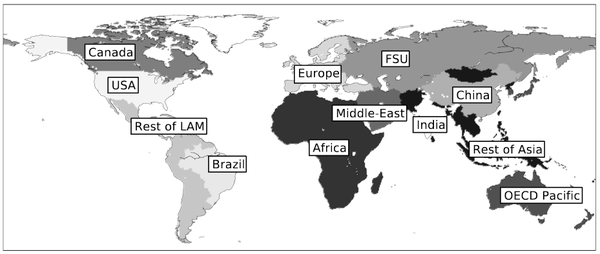Spatial dimension - IMACLIM: Difference between revisions
Jump to navigation
Jump to search
No edit summary |
No edit summary |
||
| Line 5: | Line 5: | ||
}} | }} | ||
Imaclim-R is a global model of the world economy, divided into the following 12 regions and shown in <xr id="fig:imaclim_1"/>: | |||
Imaclim-R is a global model of the world economy, divided into 12 regions | |||
*USA | *USA | ||
Latest revision as of 16:05, 29 September 2016
| Corresponding documentation | |
|---|---|
| Previous versions | |
| Model information | |
| Model link | |
| Institution | Centre international de recherche sur l'environnement et le développement (CIRED), France, http://www.centre-cired.fr., Societe de Mathematiques Appliquees et de Sciences Humaines (SMASH), France, http://www.smash.fr. |
| Solution concept | General equilibrium (closed economy) |
| Solution method | SimulationImaclim-R is implemented in Scilab, and uses the fonction fsolve from a shared C++ library to solve the static equilibrium system of non-linear equations. |
| Anticipation | Recursive dynamics: each year the equilibrium is solved (system of non-linear equations), in between two years parameters to the equilibrium evolve according to specified functions. |
Imaclim-R is a global model of the world economy, divided into the following 12 regions and shown in <xr id="fig:imaclim_1"/>:
- USA
- Canada
- Europe
- OECD Pacific
- Former Soviet Union
- China
- India
- Brazil
- Middle East
- Africa
- Rest of Asia
- Rest of Latin America
<figure id="fig:imaclim_1">
</figure>
